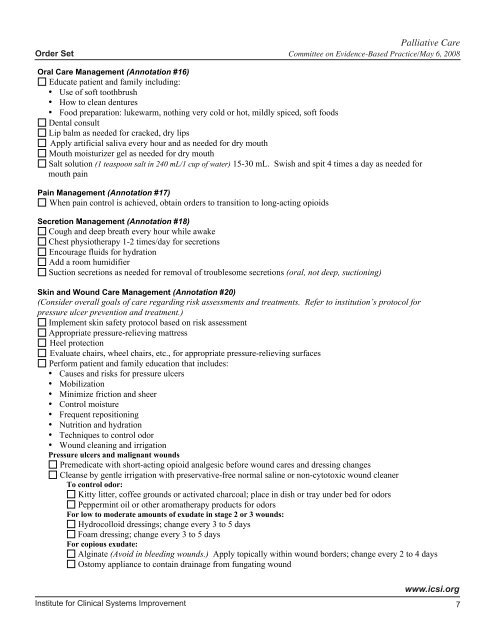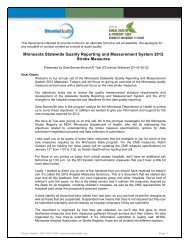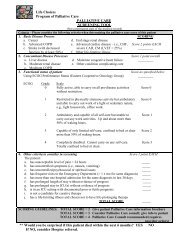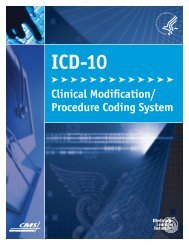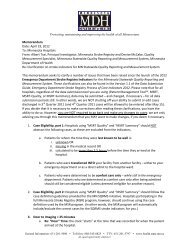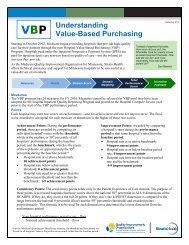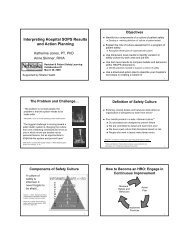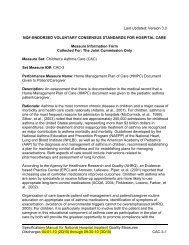Palliative Care Order Set - Stratis Health
Palliative Care Order Set - Stratis Health
Palliative Care Order Set - Stratis Health
You also want an ePaper? Increase the reach of your titles
YUMPU automatically turns print PDFs into web optimized ePapers that Google loves.
<strong>Palliative</strong> <strong>Care</strong><br />
<strong>Order</strong> <strong>Set</strong> Committee on Evidence-Based Practice/May 6, 2008<br />
Oral <strong>Care</strong> Management (Annotation #16)<br />
Educate patient and family including:<br />
• Use of soft toothbrush<br />
• How to clean dentures<br />
• Food preparation: lukewarm, nothing very cold or hot, mildly spiced, soft foods<br />
Dental consult<br />
Lip balm as needed for cracked, dry lips<br />
Apply artificial saliva every hour and as needed for dry mouth<br />
Mouth moisturizer gel as needed for dry mouth<br />
Salt solution (1 teaspoon salt in 240 mL/1 cup of water) 15-30 mL. Swish and spit 4 times a day as needed for<br />
mouth pain<br />
Pain Management (Annotation #17)<br />
When pain control is achieved, obtain orders to transition to long-acting opioids<br />
Secretion Management (Annotation #18)<br />
Cough and deep breath every hour while awake<br />
Chest physiotherapy 1-2 times/day for secretions<br />
Encourage fluids for hydration<br />
Add a room humidifier<br />
Suction secretions as needed for removal of troublesome secretions (oral, not deep, suctioning)<br />
Skin and Wound <strong>Care</strong> Management (Annotation #20)<br />
(Consider overall goals of care regarding risk assessments and treatments. Refer to institution’s protocol for<br />
pressure ulcer prevention and treatment.)<br />
Implement skin safety protocol based on risk assessment<br />
Appropriate pressure-relieving mattress<br />
Heel protection<br />
Evaluate chairs, wheel chairs, etc., for appropriate pressure-relieving surfaces<br />
Perform patient and family education that includes:<br />
• Causes and risks for pressure ulcers<br />
• Mobilization<br />
• Minimize friction and sheer<br />
• Control moisture<br />
• Frequent repositioning<br />
• Nutrition and hydration<br />
• Techniques to control odor<br />
• Wound cleaning and irrigation<br />
Pressure ulcers and malignant wounds<br />
Premedicate with short-acting opioid analgesic before wound cares and dressing changes<br />
Cleanse by gentle irrigation with preservative-free normal saline or non-cytotoxic wound cleaner<br />
To control odor:<br />
Kitty litter, coffee grounds or activated charcoal; place in dish or tray under bed for odors<br />
Peppermint oil or other aromatherapy products for odors<br />
For low to moderate amounts of exudate in stage 2 or 3 wounds:<br />
Hydrocolloid dressings; change every 3 to 5 days<br />
Foam dressing; change every 3 to 5 days<br />
For copious exudate:<br />
Alginate (Avoid in bleeding wounds.) Apply topically within wound borders; change every 2 to 4 days<br />
Ostomy appliance to contain drainage from fungating wound<br />
Institute for Clinical Systems Improvement<br />
www.icsi.org


